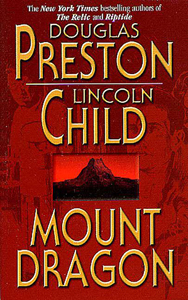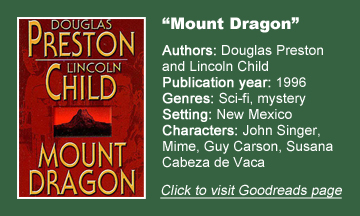Douglas Preston and Lincoln Child’s second book together, “Mount Dragon” (1996), is a mix of harrowingly current (the threat of a virus that could cause a deadly pandemic) and outdated (an early example of a very intuitive, user-friendly website).
They arguably pour too much into one novel; for example, the closing chase through the hot New Mexico desert touches upon thirst, the importance of watering your horses, Anasazi ruins and other issues they’d explore with more passion in “Thunderhead.”
Cutting-edge science
“Mount Dragon” starts off as a science-heavy book in the strain of Michael Crichton’s “The Andromeda Strain,” though. Along with protagonist Guy Carson – who is usually the POV character, but not always – we get a tour of the cutting-edge GeneDyne facility in a remote part of New Mexico near the old Manhattan Project test.
“Outbreak” and “Contagion” show us Level 4 facilities, but we know things are really dangerous here because it has a Level 5 room underground, where Gus and his assistant Susana Cabeza de Vaca and many other scientists work on X-FLU. It’s intended to be a cure for the flu that would alter a person’s genes to make them immune.
When the authors use the Crichtonian trick of listing blocks of data as Gus and Susana dig into the mystery of why employees are acting weird, there’s a definite “Jurassic Park” vibe. The answers are in the numbers, but despite all the precautions at the facility, chaos can break out if everyone overlooks one thing. We don’t need Ian Malcolm to warn us.
Preston and Child are awkward and dated in their politicizing of the ethics of genetic engineering in “Mount Dragon,” but it is interesting to note that society now seems to have moved past fears of GMO tomatoes, at least.
Or it could be that other issues are in the spotlight for now. But the genetic-modification fears and the emphasis on the wonders of the internet do place “Mount Dragon” at its time of publication more than most P&C works.
Polarizing views
While Gus may be the main character, the people holding the two polarizing views are GeneDyne’s Scopes and anti-genetic-engineering activist Levine. They aren’t written consistently; Scopes starts as a genuine “man of the people” type of boss and turns into a supervillain, and Levine starts as a sheltered professor and turns into a brave amateur computer hacker.
Still, I love “The Game” that these friends-turned-rivals play, wherein they start with a word and each must think of a quotation with that word in it.
The authors view Levine as the hero for trying to stop X-FLU and PurBlood (the previous GeneDyne project that has taken a dark turn) and for refusing to renew the patent for their co-created genetically engineered corn. Levine believes it should be free to the world; Scopes believes he has the right to profit from it, and that by doing so he is also helping the world.

Although they both make valid points, P&C’s leaning toward Scopes being the villain gets locked in with a particularly villainous action.
Levine gets remote hacking assistance from Mime, who Pendergast fans will recognize as a helper of the FBI agent, although that doesn’t start until “Still Life with Crows.” P&C ultimately envision a complex GeneDyne website, but a lot of the early computer marveling is courtesy of a chat program like Facebook Messenger, something we now use without even thinking about it.
Hint of romance
Outside of “Mount Dragon’s” themes, it’s also a romance novel, quite a change from “Relic,” although this is a shallow version of the genre. Guy and Susana bicker upon their first meeting, and there can be no question they’ll eventually get together.
Also somewhat clunky is the writing of Nye, the New Mexico facility’s security head, going insane as a result of taking PurBlood. He imagines seeing a younger version of himself directing him through the desert.
“Mount Dragon” is a mix of things that aren’t novel anymore (computer hacking and GMO fears as headline grabbers) and a medical mystery that actually has increased relevance now that a pandemic is everyday reality rather than a theoretical threat.
It’s not one of P&C’s masterpieces, but “Mount Dragon” ultimately compares to “The Andromeda Strain” almost as favorably as “Relic” compares to “Jurassic Park.”


